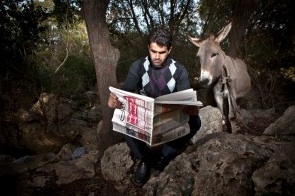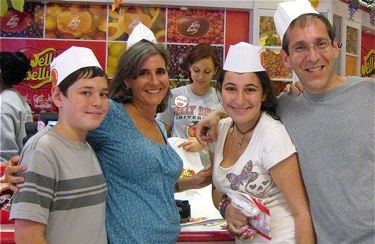We visited one of Israel’s most unusual museums last week. The Umm el-Fahem Art Gallery, in the Israeli Arab town of the same name, is a small gem, way off the usual museum track, and absolutely worth the visit if you’re traveling between Tel Aviv and the Sea of Galilee…and even if you’re not.
The Gallery houses several rotating exhibitions and a permanent floor exploring the history of Umm el-Fahem and the greater Wadi Ara environs. The Gallery’s aim is to bring contemporary art of all types – not just from Arab and Palestinian artists – to an area that has been mostly devoid of museums of this kind.
To wit, the current exhibitions include a series of striking portraits of men and women from Arab villages, adorned by jewels and beads glued on top of the paintings themselves, by artist Fatma Abu Rumi; impressionistic images of cityscapes from the Former Soviet Union by Nidal Gabarin, who left Israel to train in Russia; a collection of large framed photographs from Ammar Younis, all of which prominently feature donkeys in often amusing settings; and a playful exhibition of ceramic sculptures by Jewish artist Rafi Munz which adorn the Gallery’s rooftop, overlooking the sprawling town with its 50,000 inhabitants.
The Gallery’s biggest claim to fame, perhaps, was the 1999 exhibition of Yoko Ono’s “Open Window.”
We visited the Art Gallery with a group of 30 other Jerusalemites and were hosted by 55-year-old Said Abu-Shakra, the gallery’s founder and director who is an artist himself and a former policeman. He laid out his vision for the future of art in Umm el-Fahem.
The Art Gallery was founded in 1996 in a 100 square meter space. A few years ago, it moved to its current location with 1,500 meters on three floors. Abu-Shakra has commissioned plans that will expand the gallery again in a stunning architectural design that will hang over the Umm el-Fahem’s main street.
Local residents don’t tend to visit art galleries, Abu-Shakra told the group. So the design will force people to pass under the building, coming at least into proximity to the gallery. Abu-Shakra hopes that some of those transversing the town will eventually stop and visit the gallery itself.
“We knew the cultural situation in Umm el-Fahem and most of the Arab sector was close to zero,” Abu-Shakra said in an interview with Arieh O’Sullivan earlier this year. “But I’m not blaming anyone. I’m here to build.”
Abu-Shakra provided an example in an interview with Hadassah Magazine. He invited his neighbor Yousef, a gardener, to the opening, he explained. “The next day I saw him and said ‘Hey Yousef, why didn’t you come?’ And Yousef said: ‘I did come, with my two sons, but we stood in the door and looked in and when I saw all those fancy people inside with suits and ties, I looked at myself and said, this isn’t for me, and I went home.’ Yousef represents 80 percent of the people here. My challenge is how to reach these people and make them feel part of what we are doing.
Building won’t be cheap: the plan for the new museum, which has been allocated a 4-acre plot, requires a not insignificant $40 million to be realized. Abu-Shakra said he’s willing to build in phases.
An art gallery in Umm el-Fahem is all the more surprising given the town’s recent, violent history. In October 2000, three residents were killed by Israeli police during riots that swept through the Wadi Ara region. Then, in March 2009, members of the Israeli right marched through the town (under police protection), resulting in clashes in which 16 were wounded.
The Gallery receives some money from the Israeli Ministry of Culture, as well from donors abroad. It’s hard to raise money from the local population, Abu-Shakra said, which is struggling just to make ends meet amid severe poverty and unemployment. Some 40,000 visitors came in 2010. If Abu-Shakra has his way, that will increase dramatically.
If you like discovering the off-beat or lesser known attractions in Israel, now is the time to visit – before the Umm el-Fahem Art Gallery becomes the next big thing.
This article appeared yesterday on Israelity.



{ 1 comment… read it below or add one }
I was really glad to see your article. I am an American woman, volunteering and living at the gallery for six weeks. (My apartment opens up onto the wonderful rooftop sculpture garden, how lucky can one get?!) It has been an extraordinary experience so far. I second all the positive things you describe, and hope your story will encourage more people to visit. All the groups, Israeli and American, that have visited while I’m here have conveyed their admiration of the gallery and what Said is doing here. Just one small correction: Fatima’s paintings are almost all self portraits, and a couple are of her father. There is one, as you enter the exhibit, of an Arab woman.Mostly, she is exploring issues of identity, painting herself veiled, partly veiled, without veil. One of the most wonderful things I have seen here is groups of small local children, being guided through the gallery, and being given veils to play with and wear in the room with Fatima’s paintings!